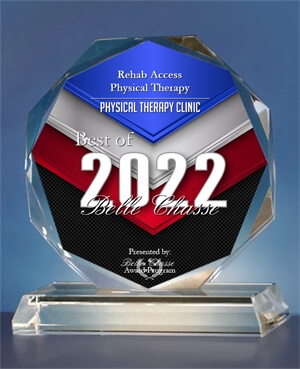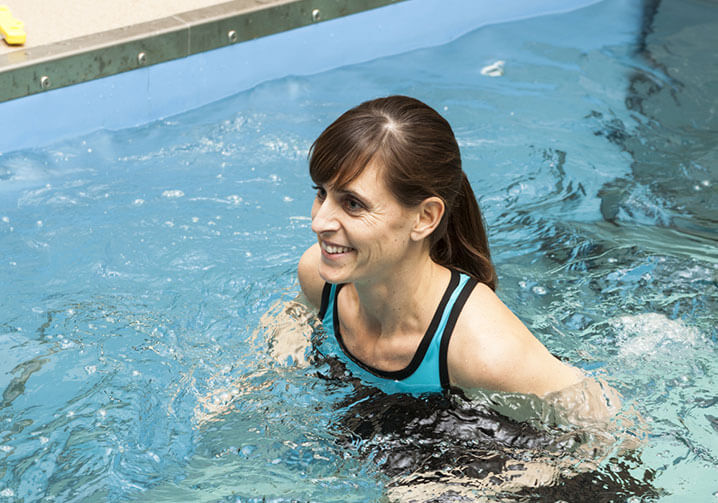In aquatic therapy, a licensed physical therapist conducts exercises and activities that target a painful and/or swollen area in your body. These exercises take place in a heated pool. For example, your physical therapist may use their hands to gently loosen your injured muscles (i.e., use passive exercises) during aquatic therapy. They may also instruct you on how you can loosen and strengthen your injured muscles (i.e., use active exercises).
Understanding how aquatic therapy differs from swim class can help you determine which option is right for you. Here are some key differences between the two:
- People involved — Unlike swim class, aquatic therapy involves a physical therapist guiding you through specific exercises in a heated pool. This physical therapist monitors your progress throughout each aquatic therapy session.
- Target areas — Swim class involves exercising your whole body, whereas aquatic therapy focuses on strengthening or working a specific area of your body. For example, if you have lower back pain, your physical therapist may recommend aquatic therapy sessions focused on strengthening the muscles in your lower back.
- Tactics — In swim class, you can strengthen your muscles only when floating. However, in aquatic therapy, you can strengthen specific muscles through exercises and activities that don’t necessarily require you to float or to go completely underwater. For example, if you have ankle pain, your physical therapist may recommend exercises that require you to go in the water only up to your waist.
Benefits of aquatic therapy
Chronic pain refers to pain that lasts for at least three months. Research suggests that aquatic therapy can improve the overall physical fitness of adults with and without chronic conditions.
The benefits of aquatic therapy apply to people of all ages. Here are some benefits of aquatic therapy:
- Relieving swelling and pain — The buoyancy of the water (i.e., your ability to float in the water) places less pressure on your joints, which can reduce swelling and pain. For example, if you have rheumatoid arthritis, you may feel a stiffness in the joints that connect your fingers to your hands. In aquatic therapy, a physical therapist can help you reduce the pressure in these joints through exercises that submerge them in the water of the heated pool. In addition, research suggests that aquatic therapy can reduce persistent lower back pain.
- Enhancing walking abilities — If you have difficulty walking because of muscle pain or weak muscle coordination, aquatic therapy may be a helpful treatment option. The buoyancy of the water can improve your joint mobility by easing the weight you’re carrying as you move, which can make it easier for you to do daily activities like walking. Also, the water’s buoyancy makes things easier on your nervous system, which can improve the coordination of your muscles as you walk. Therefore, you may be less likely to fall while walking.
- Strengthening supporting muscles — Improved joint mobility applies to both your injured joint and the muscles that support it. These supporting muscles include the muscles in your torso, pelvis and legs. By improving the mobility of your injured joint and its supporting muscles, you can improve your overall muscle strength and coordination.
- Exercising more safely — Exercising on the ground comes with the risk of falling or dropping weights on yourself. These types of injuries can worsen your pain, which can lead to a longer recovery time. On the other hand, aquatic therapy involves exercising in a heated pool in which the water supports your body. With this support, you’re less likely to fall. Also, physical therapists often use weights that can float on the water, which means that you don’t have to worry about dropping a weight on yourself.
- No equipment necessary — Many aquatic therapy exercises can be done with just yourself and your physical therapist guiding you. No equipment is needed, which can make these exercises easier to complete.
- Participating regardless of fitness level — The buoyancy of the water makes it easier to move than it would be on land. Therefore, even if you’re concerned about your fitness level, you can still easily complete aquatic therapy exercises. For example, research suggests that aquatic therapy can help older adults improve their balance.
PT techniques that you can use along with aquatic therapy
Depending on your needs, your physical therapist may recommend other PT techniques that you can combine with aquatic therapy. Here are some common PT techniques:
- Dry needling — Dry needling is a PT technique used to access the deep parts of your injured muscles. This technique involves a licensed physical therapist gently placing a hollow, dry needle into your injured area. For example, if you have lower back pain, then your physical therapist would place the dry needle into your lower back. Don’t worry — this dry needle doesn’t include any medication or injection. Also, this technique is not associated with any major pain or discomfort. When your physical therapist places the dry needle into your injured area, you should only feel your muscles slightly tighten and then quickly relax.
Through dry needling, you can experience less pain in your injured area. Here are some conditions that dry needling can help treat:
- Neck pain.
- Back pain.
- Hip pain.
- Knee pain.
- Muscle spasms.
- Headaches.
- Manual therapy — Manual therapy is a PT technique used to increase your mobility and reduce pain, swelling and muscle stiffness. Before performing manual therapy, your physical therapist will examine your injured area to determine what type of manual therapy techniques will work best for you.
One common manual therapy technique is soft tissue mobilization. For example, if you have pain in your knee joint, then the muscles near your knee may be too tight. During soft tissue mobilization, your physical therapist can break up scar tissue by gently placing pressure on your injured area (e.g., on your knee joint). Your therapist may also guide you through exercises to stretch your knee.
Another common manual therapy technique is joint mobilization. For example, if you have neck pain, then your physical therapist can quickly place pressure on the area for a brief period. The goal of joint mobilization is to loosen up the muscles in your injured area, which can reduce your pain.
The buoyancy of the water you experience during aquatic therapy can amplify the benefits of both dry needling and manual therapy. For instance, buoyancy reduces the pressure on your joints, which can make it easier for your physical therapist to loosen up your injured muscles after an aquatic therapy session. The easier it is to loosen up these muscles, the quicker your recovery period may be.
Rehab Access offers aquatic therapy for a variety of conditions
Seeking aquatic therapy? Nearly each Rehab Access location offers aquatic therapy. Here are some issues that our aquatic therapy service can help treat:
- Arthritis.
- Shoulder pain.
- Low back pain.
- Hip, knee and ankle pain.
- Difficulty with walking.
At Rehab Access, we value high-quality patient service. To get started, you can receive a free screening at one of our clinics. During this session, our licensed physical therapists can work with you to create an individualized treatment plan. Our physical therapists value listening to your goals and implementing them into your treatment plan.
We’re here to help you improve the quality of your life through aquatic therapy exercises. Call us or request an appointment today to learn more about aquatic therapy.



